
The Blue China wreck’s ceramic cargo on the ocean bottom under approximately 1,000 feet of water. (Photo, Odyssey Marine Exploration.)

Jar, Pearson and Company, Whittington Moor Potteries, near Chesterfield, England. Stoneware with Bristol glaze. Height not recorded. Mark: incised stamp, on shoulder, “Pearson & Co., Whittington Moor Potteries, near Chesterfield.” (Courtesy, Odyssey Marine Exploration.) The recovery of this jar by a fishing trawler ultimately led to the discovery of the Blue China wreck site.

Schematic map of the Blue China wreck site showing the distribution of ceramics. (Courtesy, Odyssey Marine Exploration.)

Close-up of the cargo illustrated in fig. 1. The dishes shown here would have been closely packed in wooden crates or barrels that have since rotted away. (Photo, Odyssey Marine Exploration.)

Close-up showing the retrieval of a shell-edged plate using the robotic arm of a remotely operated vehicle known as the Ultimate ROV. (Photo, Odyssey Marine Exploration.)
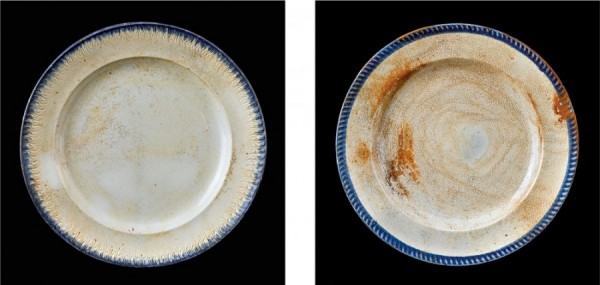
Plates, England, ca. 1845–1855. Whiteware. D. 9 7/16". (Unless otherwise noted, all artifact photography by Gavin Ashworth.) Two types of shell-edged plates were recovered whose impressed edge treatments and shades of cobalt blue differ slightly.
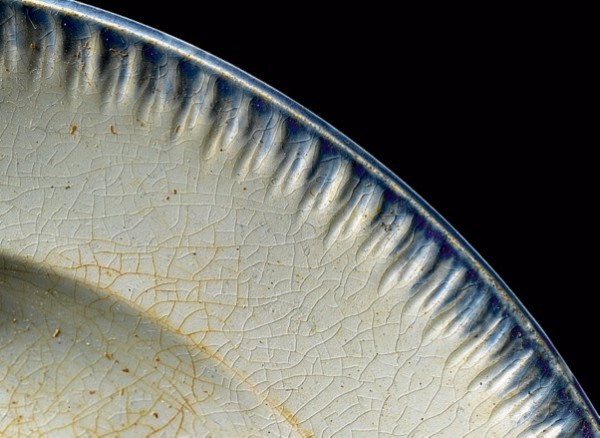
Detail of the rim of the plate illustrated at left in fig. 6.

Impressed “tally” marks from the shell-edged plates found in the Blue China wreck. These marks were used by potter workers to keep track of the vessels that came out of the kiln in good shape.
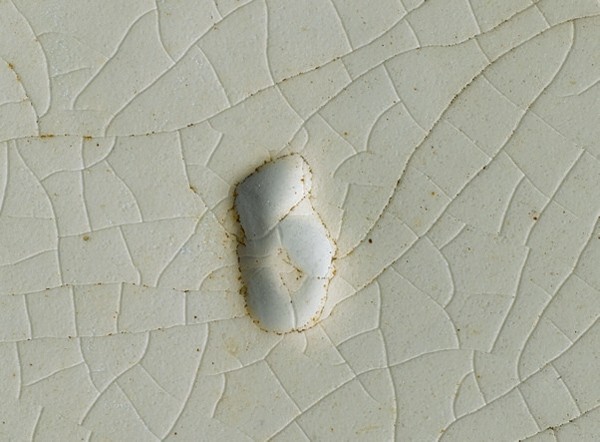
An impressed “5” from a shell-edged plate found in the Blue China wreck.

Soup plate, England, ca. 1845–1855. Whiteware. D. 10 1/2". This is one of the thirty-five shell-edged soup plates recovered from the Blue China wreck.
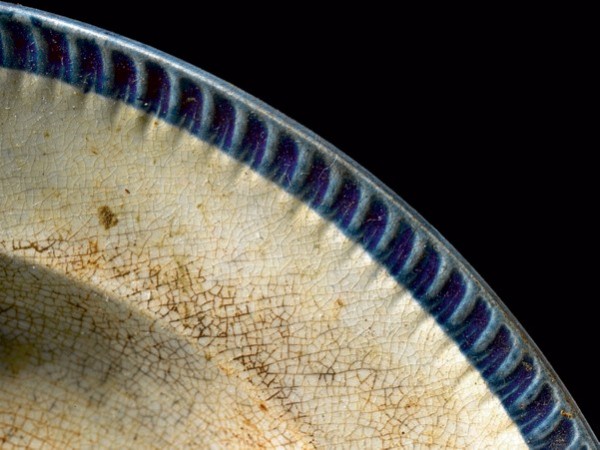
Detail of the rim of the soup plate illustrated in fig. 10.
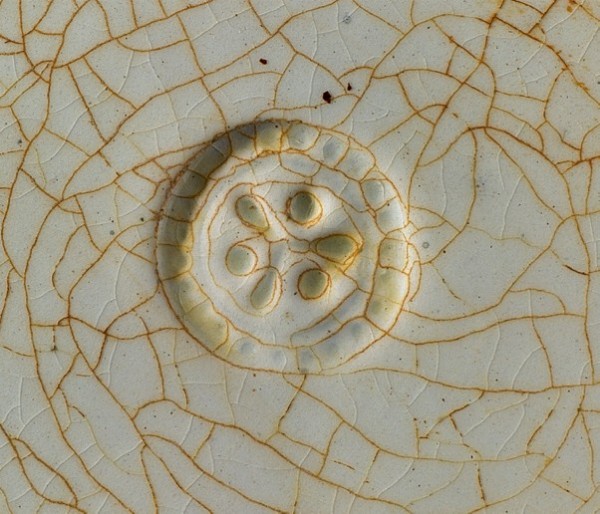
Detail of the tally mark on the base of the soup plate illustrated in fig. 10.

Octagonal dishes, England, ca. 1845–1855. Whiteware. L. of largest 15 7/16". Sixteen of these shell-edged dishes were found, in three graduated sizes.

Detail of the rim of one of the dishes illustrated in fig. 13.

Detail of the impressed tally marks on the octagonal shell-edged dishes illustrated in fig. 13.

Bowls, England, ca. 1845–1855. Whiteware. D. of larger bowl 6 1/2". Thirty-five bowls with simple dipped decoration in the “London shape” were recovered from the wreck. Two sizes are shown here.

Jugs, England, ca. 1845–1855. Whiteware. H. of larger jug 7 3/4". Eight dipped decorated jugs were found in two basic sizes.
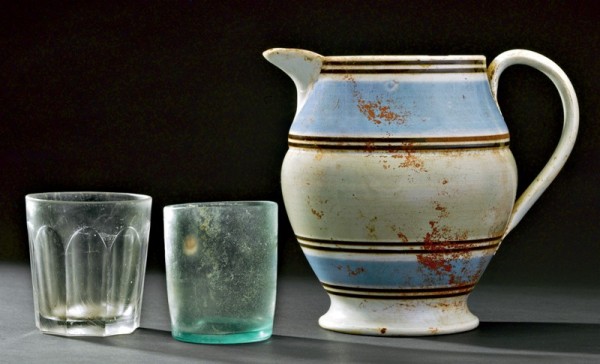
Jug and glass tumblers, England, ca. 1845–1855. Whiteware and glass. H. of jug 7 3/4". Five of the eight recovered dipped jugs contained clear glass tumblers. A sixth jug contained fragments of two green glass tumblers.

Mugs, England, ca. 1845–1855. Whiteware. H. of larger mug 4 5/8". Five dipped decorated cylindrical mugs were recovered from the wreck.
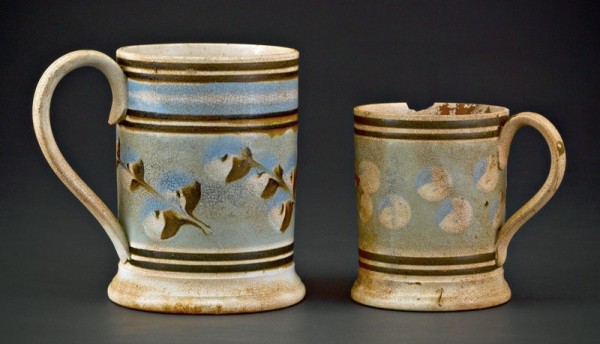
Mugs, England, ca. 1845–1855. Whiteware. H. of larger mug 4 1/2". Two of the dipped mugs are decorated with the so-called cat’s-eye slip technique.

Teabowl and saucer, England, ca. 1845–1855. Whiteware. D. of saucer 5 3/4". Twenty-six saucers and seventeen teabowls are painted in a simple floral pattern. The teabowls have a modified London shape.

Teabowl and saucer, England, ca. 1845–1855. Whiteware. D. of saucer 5 3/4".

Detail of the tally marks found on teabowls of the type illustrated in figs. 21 and 22.
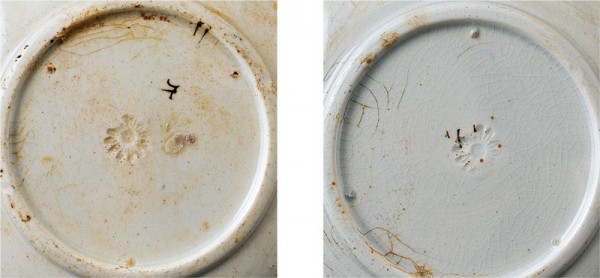
Detail of the tally marks found on the saucers illustrated in figs. 21 and 22.
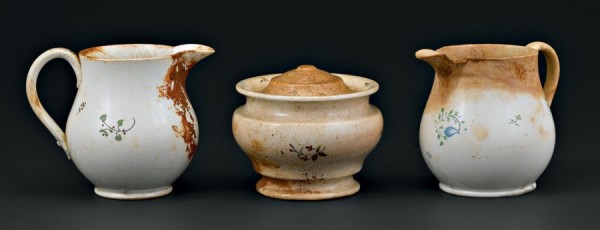
Cream jugs and covered sugar bowl, England, ca. 1845–1855. Whiteware. H. of jugs 4 7/16". Eight cream jugs and four sugar bowls were recovered among the painted teawares. The site yielded no evidence of teapots.
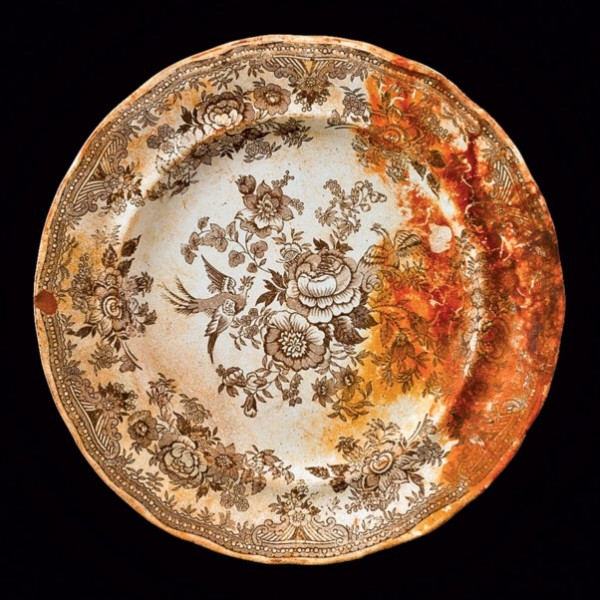
Plate, England, ca. 1850–1860. Whiteware. D. 9 3/8". A single example of this brown transfer-printed Asiatic Pheasants pattern was found. Asiatic Pheasants, among the most popular of nineteenth-century printed patterns, was used by numerous British firms.

Detail of the mark printed on the bottom of the plate illustrated in fig. 26. The Fedele Primavesi firm, active from 1850 to 1915, was located in Cardiff and Swansea, Wales, and specialized in the distribution of Welsh and Staffordshire pottery wares.

Plate, England, ca. 1845–1855. Whiteware. D. 9 3/8". This is the only example of the popular Blue Willow pattern plate found among the recovered ceramics.
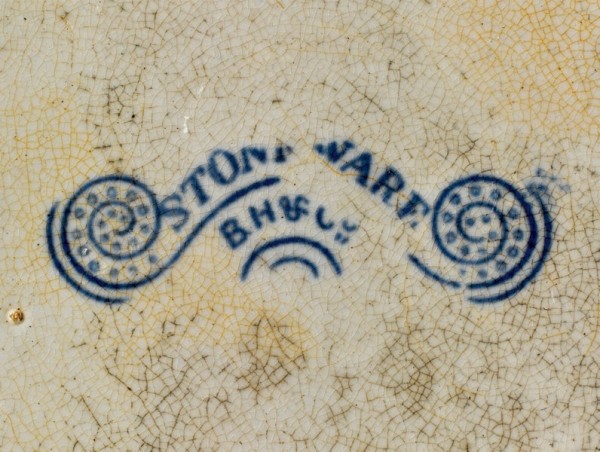
Detail of the printed mark on the bottom of the plate illustrated in fig. 28. This mark represents the firm of Beech, Hancock and Company, which started production at the Swan Banks Works in Burslem in 1851. This suggests the earliest possible date for the wreck.

Sauceboat, Staffordshire, England, ca. 1850–1860. Whiteware. H. 3 9/16". The name of this light-blue pastoral pattern has yet to be identified.

Plate, England, ca. 1850–1860. Whiteware. D. 8 1/4". Three of these unmarked, molded dinner plates were recovered.
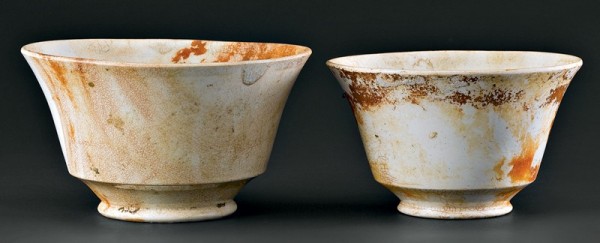
Bowls, England, ca. 1850–1860. Whiteware. H. of larger bowl 3 5/8". Fifteen of these plain bowls in the flaring London shape were found in two different sizes.
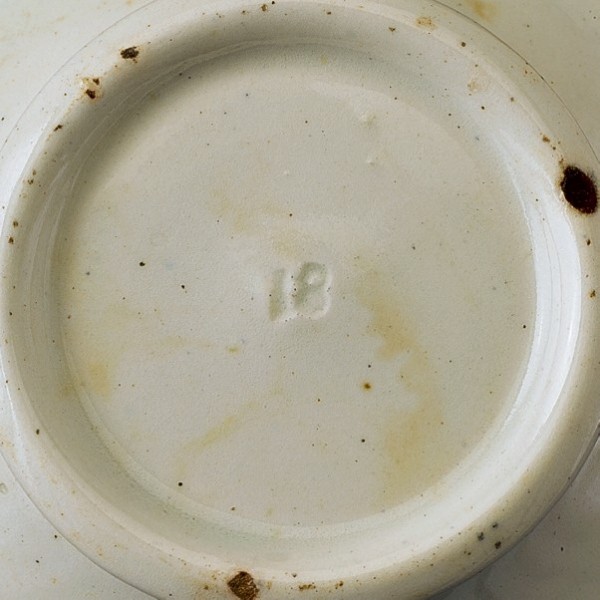
Detail of what is likely a size mark on the bottom of one of the bowls illustrated in fig. 32.

Chamberpots and basin, England, ca. 1850–1855. Whiteware. These plain but necessary toilet wares represent the least expensive ceramic ware of the period.

Salve jar, probably England, ca. 1850–1860. Whiteware. D. 3 3/16". Eleven bases and five covers from salve containers were recovered. Several of them still contain medicinal content, which has yet to be fully analyzed.
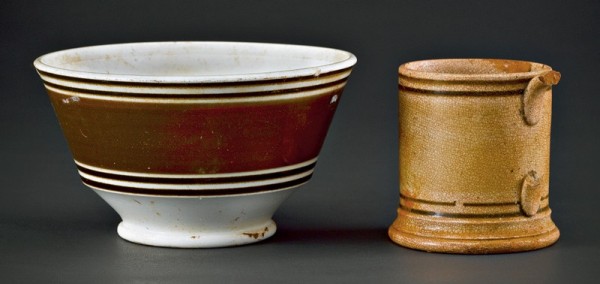
Bowl and mug, England, ca. 1850–1860. Whiteware and yellow ware. H. of mug 3". This yellow ware mug, shown next to one of the mocha bowls for comparison, was the only example recovered in the ceramic assemblage.
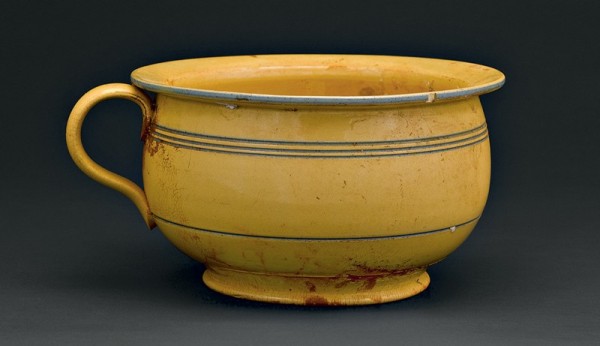
Chamber pot, England, ca. 1850–1860. Yellow ware. H. 5 3/8". The only decoration on this yellow chamber pot are five slip-trailed lines surrounding the body and rim.

Chamber pots, England, ca. 1850–1860. Yellow ware. H. 5 3/8". These two pots illustrate a blue dendritic mocha pattern applied vertically along a band of white slip.

Chamber pot, England, ca. 1850–1860. Yellow ware. H. 5 3/8". This yellow ware chamber pot has the blue dendritic mocha design applied in a horizontal band around the pot rather than a vertical one, as illustrated in fig. 38.
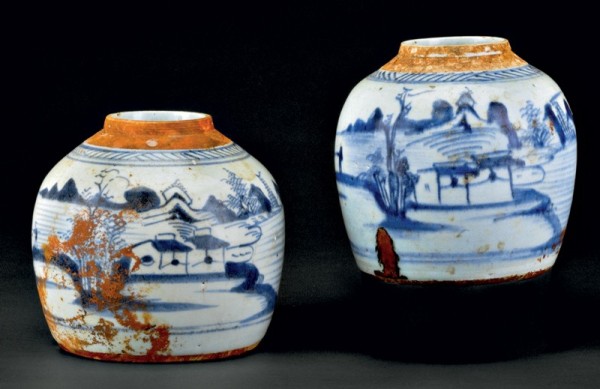
Ginger jars, Canton, China, ca. 1840–1860. Porcelain. H. 6 5/16". These blue-decorated ginger jars were common exports to England and America during the mid-nineteenth century.
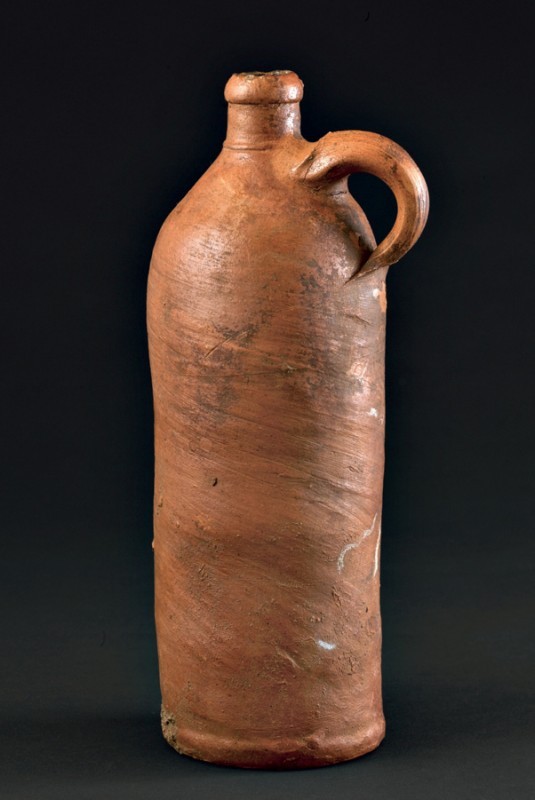
Bottle, Europe, possibly Germany, ca. 1850. Stoneware. H. 11 1/8". Jugs of this type were used to hold a variety of fluids, ranging from seltzer water to ink.

Jug, probably New York, ca. 1850–1860. Salt-glazed stoneware. H. 13". This jug was the only identifiable American-made ceramic object found at the Blue China wreck site. It may have been either part of the cargo or for use by the crew.
